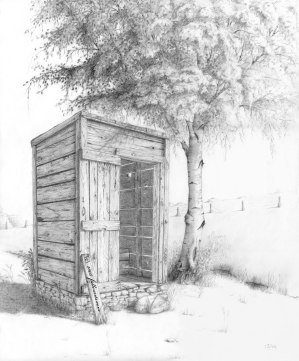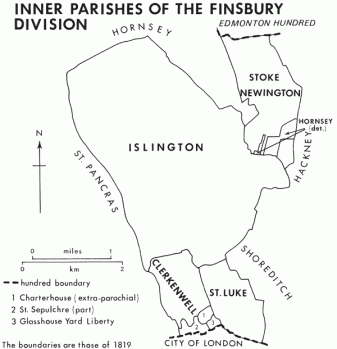The Trial of Mercy Hornby: Death of Bastard Child
Summary
Mercy Hornby of Stoke-Newington in London, U.K was found guilty for the murder of her illegitimate child on March 15th, 1734, however the trial did not take place until April 24th 1734. The child was alive when she threw it into a privy (outhouse), in which the child had suffered from bruises on the head, which then caused the child to die immediately. It is Hornby’s second transgression on the Coroner’s Inquest for a murder case. A Coroner’s Inquest is “the inquiry or investigation as to the cause of death held by the coroner’s court, a tribunal of record, consisting of the coroner and twelve jurymen (the coroner’s jury) summoned for the inquest (OED).”
These six jurors have to be citizens of the community or town that the incident causing death took place; therefore, for the trial there were at least six jurors from the town that the death occurred in. The six jurors for the trial all played many different roles in Mercy Hornby’s life, and the child’s life as well.
The first witness, Elizabeth Husk discusses that she met a woman named Mrs. Pain who was going to visit Mercy Hornby or the prisoner in Stoke-Newington. Then about an hour later, the prisoner was not in good shape, therefore Elizabeth Husk went to go see the prisoner in which the prisoner’s head and stomach hurt. When Elizabeth was at the prisoners house she took notice of her surroundings and saw a bloody-apron, and that she had seen the prisoner throw something down the cellar. At that time, it was not the child being thrown down the cellar, but when Elizabeth saw her throw something down there she noticed a child in the cellar. Therefore, Elizabeth went to her Mistress and told her what she had seen, so they went to look down in the cellar and noticed the child. This is where they saw the bruises on the child’s head, and discovered that it was a new born baby. Thus, Mercy Hornby must have been trying to hide the evidence down in her cellar.
Then the trial begins to discuss what had happened in court. They ask the prisoner and the jurors many questions. Beginning with Elizabeth in which she stated that the kitchen was filthy with the soil of the privy, and then the prisoner goes on to question Elizabeth on what she saw and the state that the baby was in. It concerns me that the prisoner was trying to cover up what she had done, by hiding the baby into the cellar so that people would never find out and would never question her. Some of the witnesses were not very helpful, as they had stated a lot of the same things that previous witnesses had said. But something interesting that the prisoner said when one witness asked her how she came to do so, and the prisoner said “The Devil prompted her.” The next witness was a mid-wife, in which she gave a valuable piece of information that the child was not a brand new, new born, that she couldn’t be that big for a new born, and that it was born alive, and not dead. The prisoner questioned whether the bruises on the baby’s head were from when it fell at its birth, but the mid wife could not say whether it was the cause of those bruises.
One of the witnesses is a surgeon, Mr. Coulson, who stated that he found a massive bruise on the side of the child’s head, which he thought to be the cause of the child’s death. However, the bruise could be from the child falling from the mother, as he stated that children fall with a great force when they are newly born. A few other witnesses, Thomas Pain, and John Jourdan discussed what the cellar was like, in which it was about 6 feet deep, with 3 and a half inches of soil, and soft sand.
Verdict
That brings us to the end of the trial, where the prisoner gives her final words, and her view of the story. This is what Mercy Hornby believes happened:
“I was taken very bad in Bed, between 5 and 6 in the Morning. I came down Stairs, and call’d for help as well as I could, but there was nobody else in the House. The next Door was an Ale-house, and a Noise being there, I believe they could not hear me. And being violent ill, and in great Extremity of Pain, I was deliver’d in the Kitchen. I never saw the Child move, nor never laid Hands on it; but it got that Bruise on the Head by falling from me, and then in a fright I took it up and carried it to the Vault.”
They discussed then went on to discuss what Mercy Hornby had done and if it could have been done out of shame, because she did have a bastard child, or maybe it actually was an accident. That being said, the verdict that the jurors gave Mercy Hornby is guilty, and she was sentenced to death.
Thoughts
What would possess a person to murder their own child? Maybe it was an accident, or maybe she had full intention of killing her child, or maybe she made it look like an accident but wanted the outcome to be of her child dying; who really knows, however they may still leave the reader quite concerned and questionable about mothers during the 1700s.
It is crazy to think that someone would actually attempt and succeed with murdering someone. It occurred to me that Mercy could have had some sort of illness, which could be anxiety, depression or post-partum depression. However she or anyone else would have not known that she had an illness because they wouldn’t be diagnosed with illnesses like depression in the 18th century.
Another aspect of the trial that I found fascinating is the fact that the jurors all had some sort of connection to Mercy Hornby. All the jurors knew Mercy Hornby or had some sort of relationship with her; therefore I believe that their opinions were biased. Due to the emotional connection and their own opinions on her, I think that their verdict would be based on what they think of her, and not really on the fact that she may have been innocent. So basically she didn’t really stand a chance against the jurors, because they most likely already had their minds made up prior to discussing with each other her verdict.
The fact that the trial puts great emphasis on the child being a bastard child, truly struck me. Therefore, I wanted to go into further research and further detail to see what exactly the stats were. I was lucky enough to find a useful article that bettered my understanding.
Bastard Children in the 18th Century
A Bastard child is “one begotten and born out of wedlock; an illegitimate or natural child (OED.” In which, that was what the child was from the Mercy Hornby trial. The study that I found discusses how there are different kinds of labeling, whether it is “foundling”, “bastard”, or “illegitimate”, they all have similar meanings, however they are also very different (Francus 87). There was a major stigma around these words during the 18th century, as the social status plays a role in it (Francus 87). People thought that foundlings were bastards, and illegitimacy was the main purpose for abandoning their child (Francus 87).
The article examines how bastard children were seen as a threat to many different areas of the family’s life; they were a threat to parents at that time that were not only poor, but also the upper class, as it would affect their status (Francus 87). Lower class and upper class did however accept illegitimacy; however the middle class families were the people that were the most threatened (Francus 87).
During the 18th century, the rich were able to provide for their legitimate and illegitimate children. The poor and the working classes were not constrained by legal marriages; therefore the illegitimate were welcomed into the family and not a disgrace (Francus 88). The middle class on the other hand had concerns as they were worried about their status and believed the illegitimate children could bring down their social status (Francus 88). The article did state that the original source did not discuss the effects of illegitimacy on class mobility; Therefore, I believe it would be interesting if there were an article out there that would discuss that.
Something that I found interesting about the article was that there were statistics on whether there were more male or female foundlings, bastards, and illegitimate children. These statistics are as following: Foundlings had a tendency to be female which were revealed to be legitimate, while bastards had a tendency to be male which were revealed to be illegitimate (Francus 88). As well, it was proven that depending on the amount of funding your family had, and social connections, played a role in the consideration of gender (Francus 88). The researcher of my article did not find any evidence to support that statement; however it is certainly something to look into (Francus 88).
Final Thoughts
Overall, I chose this trial because it really struck me and I found it immensely interesting. I have a great love for children, and it just amazed me but also made me upset to read that a mother would do that type of thing to their own child, even if it was an illegitimate child. Just because the child is considered “unwanted” in some people’s eyes, does not give the mother the right to do that. Another concern of mine was where is the father of the child during this whole thing? Society is always pointing fingers at the mother, and all the wrong that she is doing, so this aspect show’s how there are many double standards. When people think of children, they usually associate them with the mothers and not the fathers, which I do not enjoy at all. Having children is a team effort; therefore the father should be included just as much as the mother, even if it is a bastard child. Trial’s like this show just how short life is, and how precious it is. As one’s life can be taken away them in the blink of an eye. Hence, this trial certainly left me with many questions, and I am hoping that it left you as a reader with many questions too. I believe that after reading a piece of work that one should always be left pondering, and thinking. It made me wonder if she actually did hurt her child, but with the evidence that was shown, it is very hard to believe that she did not kill her child.
Bibliography
Francus, Marilyn. “Virtuous Foundlings And Excessive Bastards.” Eighteenth Century: Theory & Interpretation (Texas Tech University Press) 49.1 (2008): 87-94 Academic Search Complete. Web. 28 March. 2014
OED Online. Oxford University Press, 2014. Web. 25 March. 2014.
http://www.british-history.ac.uk/image-publicationMap.aspx?pubid=30


